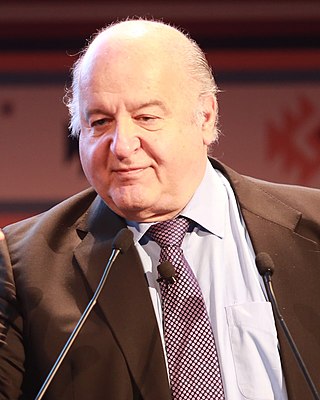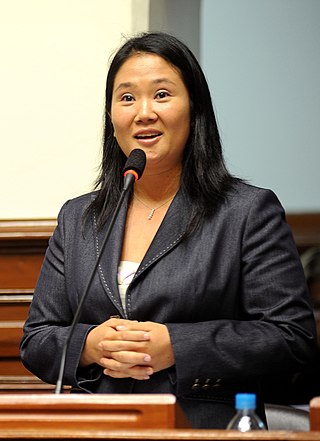The politics of the Republic of Peru takes place in a framework of a unitary semi-presidential representative democratic republic, whereby the President of Peru is both head of state and head of government, and of a pluriform multi-party system. Executive power is exercised by the President and the Government. Legislative power is vested in both the Government and the Congress. The Judiciary is independent of the executive and the legislature. The Economist Intelligence Unit rated Peru a "hybrid regime" in 2022. Traditionally weak political parties saw their support collapse further in Peru since 2000, paving the way for the rise of personalist leaderships. The political parties in the congress of Peru are, according to political scientist Lucía Dammert, "agglomerations of individual and group interests more than solid and representative parties".

The economy of Peru is an emerging, mixed economy characterized by a high level of foreign trade and an upper middle income economy as classified by the World Bank. Peru has the forty-seventh largest economy in the world by total GDP and currently experiences a high human development index. The country was one of the world's fastest-growing economies in 2012, with a GDP growth rate of 6.3%. The economy was expected to increase 9.3% in 2021, in a rebound from the COVID-19 pandemic in Peru. Peru has signed a number of free trade agreements with its main trade partners. China became the nation's largest trading partner following the China–Peru Free Trade Agreement signed on 28 April 2009. Additional free trade agreements have been signed with the United States in 2006, Japan in 2011 and the European Union in 2012. Trade and industry are centralized in Lima while agricultural exports have led to regional development within the nation.

The Peruvian Armed Forces are the military services of Peru, comprising independent Army, Navy and Air Force components. Their primary mission is to safeguard the country's independence, sovereignty and territorial integrity against any threat. As a secondary mission they participate in economic and social development as well as in civil defense tasks.
Neoliberalism, also neo-liberalism, is a term used to signify the late-20th century political reappearance of 19th-century ideas associated with free-market capitalism. The term has multiple, competing definitions, and is often used pejoratively. In scholarly use, the term is frequently undefined or used to characterize a vast variety of phenomena, but is primarily used to describe the transformation of society due to market-based reforms.

Alberto Kenya Fujimori Inomoto is a Peruvian former politician, professor and engineer who served as President of Peru from 1990 until his downfall in 2000, though de facto leadership was reportedly held by Vladimiro Montesinos, the then head of the National Intelligence Service. Frequently described as a dictator, he remains a controversial figure in Peruvian politics. He was sentenced to 25 years in prison for human rights abuses during his presidency but was released after 16 years on 6 December 2023 following an order by the Constitutional Court of Peru.

Peru, officially the Republic of Peru, is a country in western South America. It is bordered in the north by Ecuador and Colombia, in the east by Brazil, in the southeast by Bolivia, in the south by Chile, and in the south and west by the Pacific Ocean. Peru is a megadiverse country with habitats ranging from the arid plains of the Pacific coastal region in the west to the peaks of the Andes mountains extending from the north to the southeast of the country to the tropical Amazon basin rainforest in the east with the Amazon River. Peru has a population of over 32 million, and its capital and largest city is Lima. At 1,285,216 km2, Peru is the 19th largest country in the world, and the third largest in South America.
Vladimiro Lenin Ilich Montesinos Torres is a Peruvian former intelligence officer who was the long-standing head of Peru's National Intelligence Service (SIN) and was reportedly the de facto leader of Peru while President Alberto Fujimori served as a figurehead leader. Montesinos had strong connections with the U.S. Central Intelligence Agency (CIA) for over 25 years and was said to have received $10 million from the agency for his government's anti-terrorist activities, with international bank accounts possessed by Montesinos reportedly holding at least $270 million. The United States reportedly supported the candidacy of Fujimori during the 1990 Peruvian general election due to his links to Montesinos and ignored human rights abuses performed under Montesinos during the 1990s. In 2000, the infamous "Vladi-videos" came to light when they were broadcast on the news. They were secret videos recorded by Montesinos that showed him bribing elected congressmen into leaving the opposition and joining the pro-Fujimori group of the Congress. The ensuing scandal caused Montesinos to flee the country and prompted Fujimori's resignation.

Hernando Soto Polar is a Peruvian economist known for his work on the informal economy and on the importance of business and property rights. His work on the developing world has earned him praise worldwide by numerous heads of state, particularly for his publication The Mystery of Capital and The Other Path. He is the current president of the Institute for Liberty and Democracy (ILD), a think tank devoted to promoting economic development in developing countries located in Lima, Peru.

A self-coup, sometimes known as the Fujimorazo, was performed in Peru in 1992 after President Alberto Fujimori dissolved the Congress as well as the judiciary and assumed full legislative and judicial powers. With the collaboration of the military, the Fujimori government subsequently began to implement objectives of the Green Plan following the coup.

Keiko Sofía Fujimori Higuchi is a Peruvian politician. Fujimori is the eldest daughter of former Peruvian president Alberto Fujimori and Susana Higuchi. From August 1994 to November 2000, she held the role of First Lady of Peru, during her father's administrations. She has served as the leader of the Fujimorist political party Popular Force since 2010, and was a congresswoman representing the Lima Metropolitan Area, from 2006 to 2011. Fujimori ran for president in the 2011, 2016, and 2021 elections, but was defeated each time in the second round of voting.

Peru and the United States established relations on May 2, 1826, following Peru's independence from Spain.

Women in Peru represent a minority in both numbers and legal rights. Although historically somewhat equal to men, after the Spanish conquest the culture in what is now Peru became increasingly patriarchal. The patriarchal culture is still noticeable. Contraceptive availability is not enough for the demand, and over a third of pregnancies end in abortion. Maternal death rates are also some of the highest in South America.

The National Population Program, known as the National Program for Reproductive Health and Family Planning from 1996 to 1998, was a project conducted in Peru in through the 1990s to reduce population growth as a way of meeting international demographic standards. Plans for the "total extermination" of impoverished Peruvians through sterilization were included in Plan Verde, a covert military operation created to establish a neoliberal military junta. Compulsory sterilization, which is a method that forces individuals to partake in sterilization operations, was the main method employed by the Peruvian government to decrease population.

Forced sterilization in Peru was part of a larger effort variably described as the ethnic cleansing or genocide of indigenous peoples of Peru that occurred under the government of Alberto Fujimori through his National Population Program, with the such projects first being outlined in the Plan Verde of the Peruvian Armed Forces. More than 300,000 Peruvians – the majority impoverished or indigenous women – were sterilized during the Fujimori administration. The generational shift from the sterilizations resulted in the decimation of rural economies and an increase in poverty in those regions.
Carlos Boloña Behr was a Peruvian economist and politician. He served as the Minister of Economy and Finance from 1991 to 1993, and again from July to November 2000 under the administration of President Alberto Fujimori.
Censorship in Peru has been prevalent throughout its history. There have been multiple shifts in the level of freedom of the press in Peru, starting in the late 1900s when the country was oppressed, to the early 2000s when the country experienced more freedom; only recently has the country been ranked as partly free. After the neoliberal economic policies implemented in the 1990s stabilized the national economy and led it to an economic boom in the 21st century, usage of TV and access to internet has vastly increased, leading to more spaces of expression.

Alberto Fujimori served as the 54th President of Peru from 28 July 1990 to 22 November 2000. A controversial figure, Fujimori has been credited with the creation of Fujimorism, defeating the Shining Path insurgency in Peru and restoring its macroeconomic stability. However, he was criticized for his authoritarian way of ruling the country and was accused of human rights violations. Even amid his prosecution in 2008 for crimes against humanity relating to his presidency, two-thirds of Peruvians polled voiced approval for his leadership in that period.
The "Lima Consensus," a term attributed to Harvard University's government professor, Steven Levitsky, referes to a set of economic policies that have predominated in Peru starting from the presidency of Alberto Fujimori. This term was fashioned analogously to the "Washington Consensus." In effect, the Lima Consensus is often seen as a more radical manifestation of Washington Consensus due to its proactive push for economic liberalization and a limited—and often ineffective—level of state regulation or institutional fortification.
Racism in Peru comprises negative attitudes and views on race or ethnicity which are related to each other, are held by various people and groups in Peru, and have been reflected in discriminatory laws, practices and actions at various times in the history of Peru against racial or ethnic groups. Peruvian intellectuals, who were mainly white and based in the developed capital city of Lima, historically denied that racism existed in Peru and did not focus on the social issue, often participating in racism themselves. The concentration of wealth amongst elites in Lima through centralismo resulted with a history of systemic racism in Peru, with individuals in Lima basing their discrimination against rural individuals due to race and geographical location.
Conservatism in Peru is a broad system of conservative political beliefs in Peru, characterized by support for Catholic values, social stability and social order. Peruvian conservatism has encompassed a wide range of theories and ideologies in the last two hundred years. In contrast with nearly nations like Colombia or Chile, Peru has not developed a concrete conservative political tradition.













